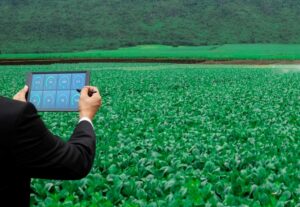Conventional farming practices all over the world are reaching their limits, prompting the adoption of highly innovative approaches like precision farming technology. The concept of precision farming encompasses diverse interpretations. According to the International Society of Precision Agriculture, precision farming is an approach that dedicatedly consists of collecting, processing, and analyzing the temporal, spatial, and individual data of farms. This data is combined with other relevant information to facilitate decision-making based on estimated variations. Simply, it’s about using technology and data to farm more innovatively and get the most out of every resource.

Source: Freepik
Top Precision Farming Technologies:
The realm of precision agriculture is strictly driven by an array of cutting-edge technologies reshaping the agricultural landscape. While the field continually evolves, some of the top precision farming technologies have gained prominence.
-
Remote Sensing:
Remote sensing collects information about the surface and atmosphere from a distance using highly specialized sensors and instruments. It provides highly valuable data on the land cover, vegetation, and atmospheric conditions, empowering well-informed decision-making. With considerable growth potential, this technology holds promising prospects for further development.
-
Market Size:
Remote sensing is highly crucial in precision agriculture, helping the farmers to look out for their assets and enabling data collection and analysis on the soil conditions, crop health, and other environmental factors. Utilizing specialized cameras on the satellites or aircraft, remote sensing imagery provides a good visual representation, aiding farmers in interpreting the landscape effectively.
-
Internet of Things (IoT):
This rising need for food production for the growing population is a crucial driver of IoT usage in farming. IoT adoption in agriculture claims that the central focus of IoT solutions is to facilitate the farmers in balancing supply and demand dynamics. In precision farming, IoT technology uses different interconnected sensors and devices for gathering real-time data and evaluating diverse parameters like temperature, soil moisture, and crop health. A specific use case of IoT applications is the aforementioned remote sensing. While IoT focuses on urgent data collection from connected devices, remote sensing is about gathering data from afar using imaging technologies.
-
Unmanned Aerial Vehicles (UAVs) or Drones:
Drones, or unmanned aerial vehicles (UAVs), are different flying devices that operate irrespective of any human pilot, either controlled remotely or have programmed to fly autonomously. This precision farming technology has emerged as a very valuable tool in agriculture, especially for remote sensing — equipped with the sensors and cameras, drones provides farmers with a bird’s-eye view of their fields. This enables efficient monitoring of crop health, disease detection, and pest control. Drone spraying techniques optimize application of pesticides and fertilizers, resulting in an increased yields and cost savings. Furthermore, drone mapping potentials help identify distressed areas in the field, permitting targeted interventions and improved crop management.
-
Automated and Robotic Systems:
Automation and robotics have made considerable advancements in agriculture, revolutionizing labor-intensive tasks. Automated and robotic systems perform several tasks like planting, harvesting, and weeding, precisely and accurately. Powered by advanced technologies like artificial intelligence, they optimize allocation of resources, reduce waste, and boosts overall productivity.
-
Big Data & Analytics:
Today, farmers can make better decisions thanks to the huge amounts of data they can gather from different sources, namely remote sensing and IoT networks. With all this data, businesses can also sift through it with very advanced analytics solutions and find innovative ways to enable optimal resource allocation, crop planning, and effective management of challenges like pests and adverse weather.
The experimental results indicate that implementing the extensive data analytics agriculture monitoring system brings about several benefits, including predicting crop yield, reducing labor, and enhancing agriculture monitoring systems. By employing the convolutional neural networks, the system acquires raw images from UAVs. It facilitates early predictions of crop yield based on predefined parameters.
-
Farm Management Software:
Custom farm management software provides farmers an all-in-one platform, optimizing planning, real-time tracking, and decision-making.
The applications and use cases of farm management software vary across combinations, offering highly versatile solutions to meet diverse agricultural needs. For example, livestock monitoring becomes a walk-in-the-park with farm management software.
Conclusion:
The prospects for using precision technologies in farming are very bright, driven by the growing desire among farmers to embrace these innovative tools. Globally, 39% of farmers have adopted or are willing to adopt at least one farming technology. Precision farming is a comprehensive system beyond traditional farming methods, starting from crop planning and extending throughout the entire agricultural lifecycle, including post-harvest processing.
Contact SoilOptix®expert to learn more about this!
